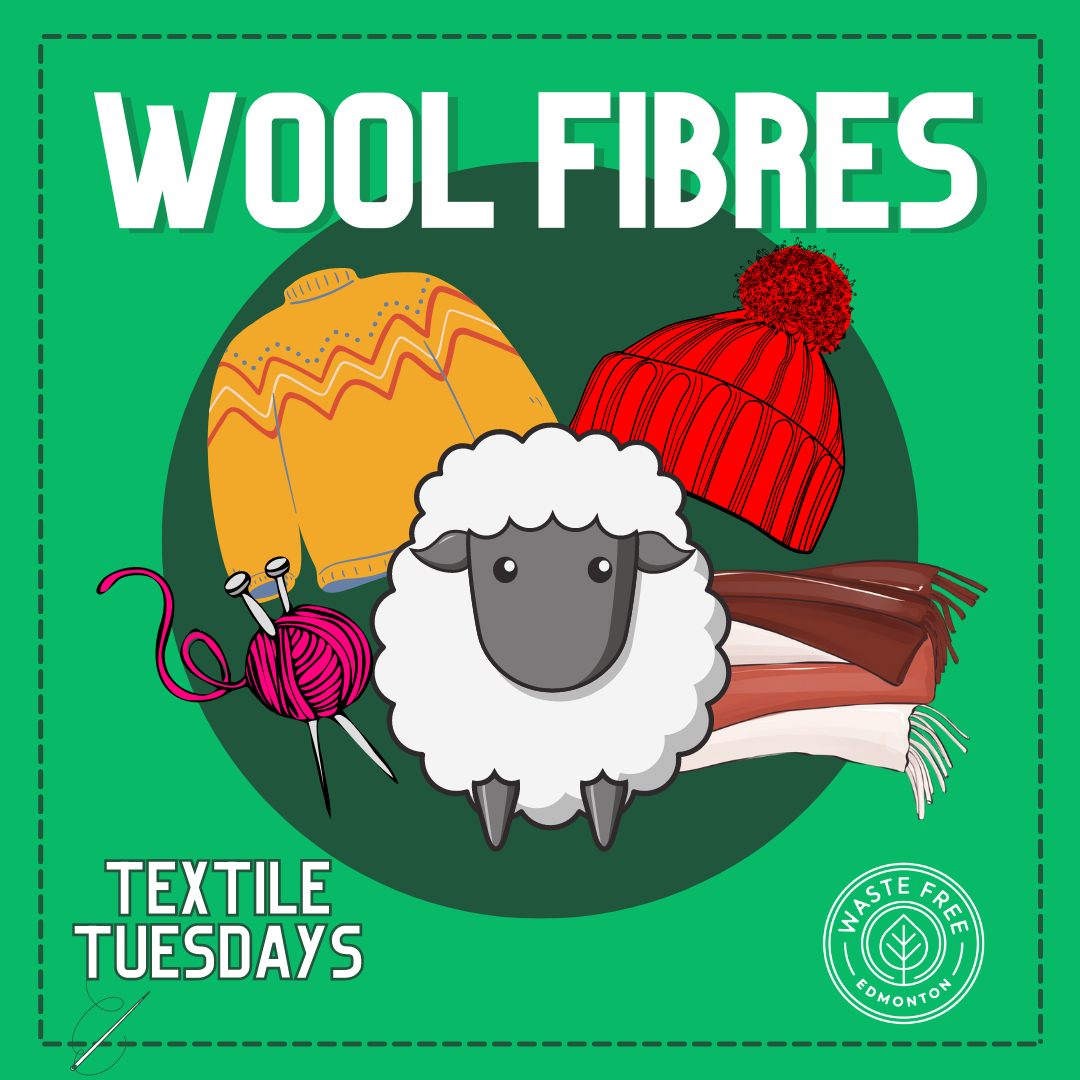Today we’re talking about the next fibre in our series, wool. To put it simply, wool is basically sheep hair, and is actually similar to human hair in many ways! Wool is made of a protein called keratin, and the outer surface is covered with protective scales. Australia is the world’s largest producer of wool, followed by China, Russia, New Zealand, Argentina, South Africa, the UK and Uruguay.
Wool was once very popular, but is now one of the least used textile fibres. This is primarily due to cost, as other fibres are much less expensive; wool is often blended or substituted with acrylic, polyester, or nylon to reduce cost. Wool is mostly used in winter apparel and accessories such as toques, mitts and sweaters, and in next-to-skin items like baselayers and socks for its thermal and moisture management properties. Wool is also still used in high-end carpeting due to its resilience. Here are some quick facts about wool:
- Pros:
- Very resilient/durable, and warm!
- Can absorb 1/3 of its weight in moisture vapour without feeling wet
- Doesn’t hold on to body odour, can be worn multiple times between washes
- Cons:
- Vulnerable to clothes moth damage
- Can be itchy due to the surface scales. Finer varieties like merino are more comfortable
- Can be difficult to wash – the scales can interlock and cause felting shrinkage
- Machine washable wool (superwash) is treated with the chlorine hercosett process, which could have a negative impact on the environment
- Wool comes from livestock, so humane treatment is important. The practice of mulesing is often used in regions where parasitic insects can infect the sheep
- Like cattle, sheep produce methane which is a potent greenhouse gas. Love Your Clothes rates virgin wool fibres as “Class E” (the lowest) on their environmental benchmarking chart.
Despite the drawbacks, wool is a great fibre for certain needs, and is very popular with fibre crafters and artists. But as we know, textile and clothing production generates tremendous amounts of waste. What is being done to reduce the waste generated by wool production? Here are some techniques, methods, and ways to make wool production more sustainable for both sheep and the planet.
Responsible Wool Standard
- RWS is a voluntary Textile Exchange standard which recognizes the Five Freedoms of sheep, and farmers with a progressive approach to land management.
- The Five Freedoms include freedom from: hunger or thirst, discomfort, pain, injury or disease, fear and distress, and the freedom to express normal behaviour.
- Clothing certified to RWS will be labelled as such on the company’s website, in-store, and/or on garment labels.
Regenerative wool
- This approach to wool production has been gaining traction, and is used by Sheep Inc.
- Last year, Allbirds, Icebreaker, and Smartwool announced their plans to collaborate and support the Discover ZQ ZQRX regenerative wool index, a tool for farmers to embrace and improve their techniques.
- Regenerative farming is a holistic approach, prioritising biodiversity, soil health, and bio-sequestration of carbon. Rotational grazing allows farmers to find a balance between fertilization and waste management, feeding livestock, maintaining plant growth, and reducing soil erosion.
Processing
- While the chlorine hercosett process is the most widely used superwash treatment, alternatives are available.
- Plasma treatments, as used by Südwolle Group, use an electrically-generated plasma field to even out the fibre surface, but can cause damage to the fibre if not careful.
- Other treatments include ozone, enzyme, radiation, and others. Each have their own pros and cons – you can read about them in more detail by seeing our reference list on the blog
- It’s also possible to use untreated wool! For crafters, Briggs & Little Mill is a Canadian company who doesn’t use superwash or other harsh treatments on their wool. The yarn feels a bit more “rustic” as a result, but makes great sweaters, outerwear, and mitts.
Recycled wool
- This will come up again and again with all fibres, but one of the lowest impact choices you can make is to use fibre that has already been produced.
- When it comes to recycling fibres there can be some concerns about which chemicals may be present in the source material, but you can still find items made with recycled fibre and certified to 3rd party standards such as OEKO-TEX.
- Canadian brand Anián uses recycled natural fibres, including wool, and there are more popping up all the time!
- Manteco are an Italian fabric mill who have lots of great posts about their recycled MWool® products and manufacturing process. In 2021 alone they saved over 800,000 knitted garments from landfill!
All the information above was sourced from the references below, and we hope you continue your interest in wool, fibres, and textile production by reading the links below!
References:
- http://responsiblewool.org/
- https://www.woolmark.com/environment/regenerative-agriculture/
- https://sustainablebrands.com/read/supply-chain/trending-major-brands-partner-to-cultivate-regenerative-ag-supply-chains
- https://www.discoverzq.com/zqrx
- https://www.suedwollegroup.com/blog/machine-washable-merino-without-chlorine/
- Kadolph, S. J. & Marcketti, S. B., (2017). Textiles (12th ed.). Upper Saddle River, New Jersey: Pearson Prentice Hall.
- Hassan, M. M., & Carr, C. M. (2019). A review of the sustainable methods in imparting shrink resistance to wool fabrics. Journal of Advanced Research, 18, 39-60.
- Marino, R., Atzori, A. S., D’Andrea, M., Iovane, G., Trabalza-Marinucci, M., & Rinaldi, L. (2016). Climate change: Production performance, health issues, greenhouse gas emissions and mitigation strategies in sheep and goat farming. Small Ruminant Research, 135, 50-59.
- https://doi.org/10.1016/j.jare.2019.01.014
- https://briggsandlittle.com/tour/
- https://manteco.com/mwool/


